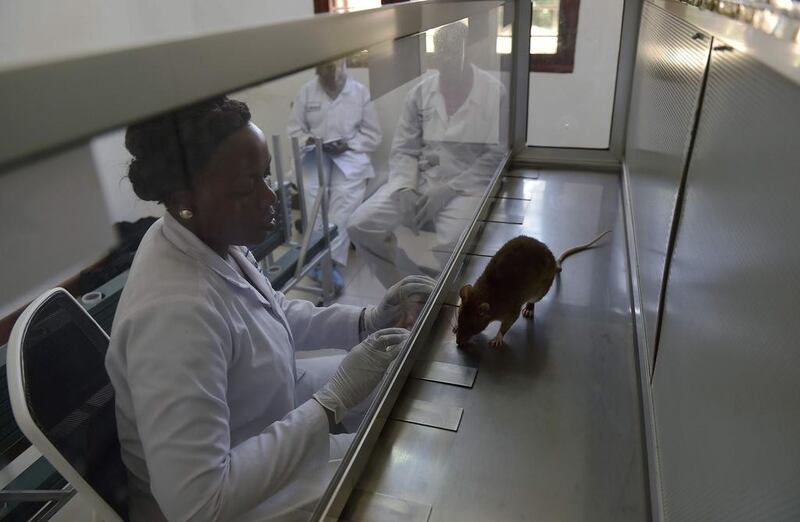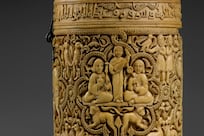Morogoro, Tanzania // They have proven their worth in detecting land mines but Africa’s giant pouched rats have a lesser-known but equally critical vocation – saving lives by speeding up tuberculosis detection.
It’s all in the nose, says the Belgian non-governmental organisation Apopo.
Its founders, in 1997, saw potential for these abundant rodents with a sense of smell as keen as a dog’s but dismissed as pesty vermin or a potential meal.
“The biggest obstacle has been the negative perception that people have of the rat,” said Apopo director Christophe Cox, whose NGO has been based in Morogoro in Tanzania’s eastern highlands since 2000.
Yet 83,000 land mines have been neutralised in Africa and Asia thanks to the rodents, Apopo says, saving countless lives where explosives still maim and kill up to 20,000 people – many of them children – each year.
Eyebrows were also raised when the group, whose acronym stands for Anti-Personnel Landmines Detection Product Development, branched out in 2007 to use rats for TB detection, under contracts with local authorities.
“When I first heard about this technique I was a bit shocked, but it proved to be quite efficient, in fact more efficient than the microscopy we use,” said Daniel Magesa, a doctor at Pasada Upendano Clinic in the capital Dar es Salaam which now sends Apopo’s Morogoro base about 200 human sputum samples every month.
Africa accounts for most of the million-plus people who die of TB each year and untreated carriers can infect dozens of others, making speedy detection essential.
“The problem is the concentration of the TB in the samples we have. It is sometimes not concentrated enough for us to see it through the type of microscopy we use, even though it is very modern,” Dr Magesa said.
“With the lack of resources, qualifications and time, hospitals in the region only detect about 50 per cent of TB cases,” said Mr Cox, a figure confirmed by Dr Magesa.
Today, more than 29 hospitals in Dar es Salaam and Morogoro send sputum samples to the Apopo lab. Another dozen clinics in the Mozambique capital Maputo send samples to an Apopo centre opened in that country in 2013.
The NGO says it has detected 10,000 missed TB cases, identified by workers like Oprah and Violet, whiskers bristling as they move along a row of test tubes.
“The big advantage is how quick the rats are. They can go through 100 samples in about 20 minutes, and this is what a lab technician will take four days to do,” said Mr Cox.
During TB detection, rats are presented with a mix of negative and positive samples, the latter decontaminated for safety “but the smell remains”, said training director Haruni Ramadhan.
When a rat identifies a “true” positive, it is rewarded with a banana-peanut butter mixture. “We can only reward the rat if we are certain it is right,” Mr Ramadhan said.
The negatives are not necessarily suspicious but become “suspect”, and subjected to further testing, if the rat reacts.
“Thanks to the rats, we have increased detection rates by 40 per cent” in the participating clinics, said Mr Cox, citing the same figure given by Dr Magesa.
Apopo now employs 222 rats – 108 for demining and 42 TB detectors.
The others are breeders or still in training, like Jon Stewart and Stephen Hawking – year-old twins named for the US television star and the British scientist – who are hard at work, poking their noses in soil studded with deactivated mines.
“In these boxes we have buried land mines, so the rats have to pass and sniff and whenever they find the smell of TNT ... he has to scratch strongly,” said chief trainer Jared Mkumba.
If they get it right, the instructor snaps a clicker, a signal that the rat can claim its reward, a bit of the banana-peanut butter concoction.
After six to nine months’ training, the “HeroRATs”, as Apopo calls them, are sent to comb former battle zones in Mozambique, Angola and more recently Cambodia, but this is no suicide mission.
At one to 1.5 kilogrammes, the rats are big enough to attach to a long, thin leash as they scan areas but light enough not to set off mines, which are cleared by human cohorts.
Another plus is the African pouched rat’s relatively long lifespan, six to eight years, its affinity for repetitive tasks and its small size, which makes it easy to house, transport and feed.
“This is a lot faster than traditional methods, because rats only detect mines while metal detectors will beep for every single piece of scrap,” said Mr Mkumba.
But they will never entirely replace other methods, he said. “Rats are more efficient when on large minefields where mines are spread, but they are useless when there are lots of mines, for minebelts for example, because we know where they are.”
The World Health Organisation has not, so far, endorsed this TB testing but Apopo, funded mainly by donations, is not stopping here. Buoyed by its success, future ideas include trying out rats in detecting cancer and neurodegenerative diseases.
* Agence France-Presse





